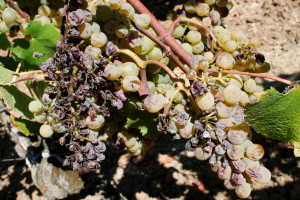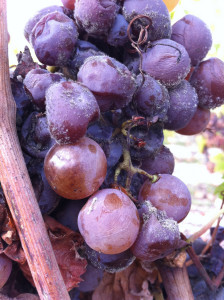Noble rot, also known as grey mold, is both a bane and a blessing for winemakers. Scientifically known as Botrytis cinerea, it is known to be devastating to many wines, though for select types of wines like
Sauternes, Tokaji Aszu, and Spätlese German Rieslings, the presence of this fungus is actually highly desirable.
Botrytis cinerea infections result in withered grapes and can lead to a finished table wine with off-flavors and aromas. Not only does this reduce the desirability and quality of the finished wine, but it ultimately leads to significant economic losses for the winery. On the other hand, in other wines like the ones mentioned above, the presence of Botrytis cinerea is actually desired, since the infection is partially responsible for the desired flavors and aromas of these finished dessert-style wines.
Another type of wine that relies on withered grapes for its quality is Amarone. Unlike Sauternes, Tokaji Aszu, and the like, Amarone grapes must be withered by drying and not via infection by Botrytis cinerea.
One problem arises is that it is rather difficult to tell the difference between grapes that are withered on their own versus grapes that are withered due to Botrytis cinerea infection. Since Botrytis cinerea is known to alter the chemical composition of Amarone wines (see an example study here), having the ability to distinguish between infected and non-infected grapes would be extremely helpful in producing desirable Amarone wines.
A new study in the journal Food Chemistry has taken a novel approach to distinguishing between infected and non-infected grapes by evaluating the individual proteins in both and comparing them to determine if certain proteins may be used as infection markers for possible use in real-time vineyard or winery assays.
Brief Methods
Corvina grapes harvested from vineyards in Valpolicella, Italy, were used in this experiment.
100 berries were infected with Botrytis cinerea in a laboratory setting, while 100 other healthy berries were used as controls.
Proteins were extracted from both healthy and infected berries and analyzed using 2D-electrophoresis, gel image analysis, and LC-MS/MS analysis.
Results
- Protein profiles were significantly different between Botrytis cinerea-infected and non-infected grapes.
- Concentrations of some proteins were significantly higher (at least 1.5X) in infected grapes compared with non-infected grapes.
- There were several proteins that were unique to Botrytis cinerea-infected grapes (not present in healthy grapes).
- The following proteins were only found in infected grapes:
- “Major protein of Woronin body” (helps during the colonization process)
- “A hypothetical acid protease”
- Peroxiredoxin-5 (a defense protein)
- Malate dehydrogenase (involved with host tissue invasion)
- ATP synthase beta chain (involved with energy metabolism)
- ATP synthase subunit alpha (involved with energy metabolism)
- 3-alpha (or 20-beta)-hydroxysteroid dehydrogenase
- Protein yjbQ with thiamine phosphate synthase activity
- “A hypothetical protein” with similarities to ribosomal protein
- “A conserved hypothetical protein”
- “Two predicted proteins”
Conclusions
The results of the study presented today successfully identified several proteins that are unique to Botrytis cinerea-infected grapes. This information could be valuable to developing a field assay for winemakers to use either in the vineyard or in the winery in order for them to better manage their grape selection for whatever style wine they are trying to make.
While this information is promising, there are still some questions that need to be asked before such a commercial test could be developed and sold.
- Are these proteins and protein concentrations conserved across grape varieties? Are these unique proteins present in other grape varieties when infected with Botrytis cinerea?
- What is the minimum level of each protein required to be detectable in a possible commercial assay?
- How soon after infection can these proteins be detected?
- Do the concentrations of these proteins change the longer a grape has been infected? How does the overall protein profile change over time?
- What are the identities of the otherwise unknown proteins that were found to be unique to infected grapes? Does that even matter considering how many others were identifiable?
- Would a commercial assay need to include tests for all of the unique proteins found? Or is there one or two proteins that are conserved in Botrytis cinerea-infected grapes that can be used?
Overall, I think the results of this study provide a lot of great information for developing an assay for winemakers to use in the vineyard or in the winery. Certainly more work needs to be done to fine tune the details, but in general this information regarding the unique protein profiles of Botrytis cinerea-infected and non-infected grapes could be very useful from a wine quality and economics standpoint.
What do you all think of this study? What other questions would you like to see answered before a commercial assay became available? Please feel free to leave your comments!
Source:




2 comments for “Unique Proteins Identified in Botrytis cinerea-Infected Grapes: Implications for Noble Rot Field Assays”